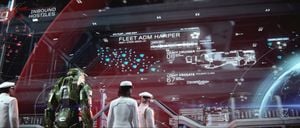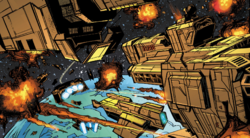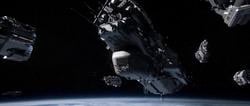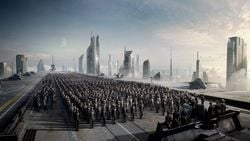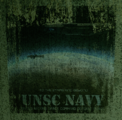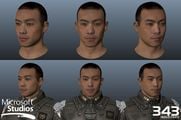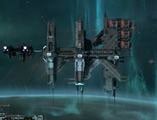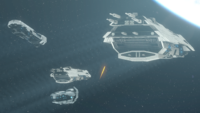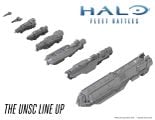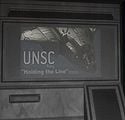UNSC Navy: Difference between revisions
From Halopedia, the Halo wiki
BaconShelf (talk | contribs) mNo edit summary |
|||
| (797 intermediate revisions by more than 100 users not shown) | |||
| Line 1: | Line 1: | ||
{{ | {{Status|Canon}} | ||
{{Military infobox | |||
|image=[[File:UNSC Navy Logo.svg|100px|class=invert-dark]]<br>The [[Symbols of the UNSC|logo of the Navy]] | |||
{{ | [[File:H2A-fleet readout.jpg|300px]]<br>Naval members [[John-117]], [[Miranda Keyes]], and [[Terrence Hood]] looking at a readout of ships | ||
| | |formed= [[2163]] | ||
| | |formed-title=Formed | ||
| | |affiliation= [[United Nations Space Command]] | ||
| | |authority= [[UNSC Naval Command|Naval Command]] | ||
| | |branch= | ||
|branch= | |type= Space force | ||
|type= | |role= Space warfare and operations | ||
|role= | |size= | ||
|size | |nicknames= Swabbies<ref name="flood">'''[[Halo: The Flood]]''', ''page 100''</ref> | ||
|battles= [[Interplanetary War]] <br> | |||
[[Insurrection]] <br> | |||
[[Human-Covenant War]] <br> | |||
[[Post-Covenant War conflicts]] | |||
|commanders= | |||
*[[Chief of Naval Operations]] | |||
**[[Fleet Admiral|FADM]] [[Terrence Hood|T. Hood]] | |||
*[[Deputy Chief of Naval Operations]] | |||
**[[Vice Admiral|VADM]] [[Danforth Whitcomb|D. Whitcomb]] | |||
| | |||
*[[ | |||
* | |||
*[[ | |||
* | |||
*[[Vice Admiral|VADM]] [[Danforth Whitcomb | |||
}} | }} | ||
The '''UNSC Navy''' ('''UNSCN''')<ref>'''[[Halo: Glasslands]]''', ''page 64''</ref> is the branch of the [[United Nations Space Command]] armed forces responsible for space warfare and operations. Its roles include [[space warfare]], [[orbital bombardment]], the deployment of atmospheric and [[space fighter]]s, and the delivery of [[UNSC Marine Corps|UNSC Marines]] into combat. | |||
The | |||
The | ==Mission== | ||
The UNSC Navy's mission is to ''"Provide naval forces to ensure freedom of access for aerospace and terrestrial operations."''<ref name="OSFM126">'''Halo: Official Spartan Field Manual''', ''p.126''</ref> More specifically, the Navy is responsible for destroying and suppressing enemy space combatants, especially those attempting to attack UEG commercial and terrestrial holdings. The Navy's collateral functions include; | |||
*Interstellar transportation of UNSC assets.{{Ref/Reuse|OSFM126}} | |||
*Development of doctrine, procedures and equipment that are of common interest to the Air Force and Marine Corps.{{Ref/Reuse|OSFM126}} | |||
*Providing forces for joint aerospace and terrestrial operations, in accordance with UNSC doctrine.{{Ref/Reuse|OSFM126}} | |||
*Coordination with UEG civil agencies for the establishment and maintenance of naval depots and orbital yards.{{Ref/Reuse|OSFM126}} | |||
*Establishment of emergency military government in designated crisis areas.{{Ref/Reuse|OSFM126}} | |||
== | ==History== | ||
===Formation=== | |||
{{Main|Interplanetary War}} | |||
The UNSC Navy was created during the [[Interplanetary War]] of the [[2160]]'s—precisely during the [[Mars Campaign]] of [[2163]]—as a result of the [[United Nations]]' need to oversee and monitor [[UNSC Marine Corps|Marine]] deployments from space, thus forming the [[United Nations Space Command]]. After the UN's victory in that war, the UNSC Navy became involved in colonization, the settling of minor trade disputes, and anti-[[piracy]] operations as humanity spread through space.<ref name="evolutions436">'''[[Halo: Evolutions]]''', "[[The Impossible Life and the Possible Death of Preston J. Cole]]", ''pages 436-437''</ref> The navy has always been a carrier-heavy organization, with carriers forming the core of doctrine and organisation.{{Ref/Reuse|WFEpoch}} | |||
The | ===The Insurrection=== | ||
{{Main|Insurrection}} | |||
[[File:Eridanus battle.png|thumb|250px|The Navy engaging insurgent vessels during Operation: TREBUCHET.]] | |||
Such low-level operations continued until the [[Insurrection]], which forced the Navy to develop a modern space warfare doctrine. Beginning with the [[Callisto Incident]] of [[2494]], the UNSC Navy was involved in a series of small but important actions against [[Insurrectionists]] across human space.<ref name="evolutions cole">'''Halo: Evolutions''', "The Impossible Life and the Possible Death of Preston J. Cole"</ref> In 2494, the [[Eridanus Government]] requested aid from the UNSC when rebels performed a well-planned and efficiently executed [[terrorism|terrorist]] campaign on the planet. This led to [[Operation: CHARLEMAGNE]] in [[2494|January of 2496]], when the UNSC Navy responded to the government's requests and began their campaign to retake Eridanus II, deploying a battle group to engage the makeshift Insurrectionist defense fleet.<ref>'''[[Halo Encyclopedia (2009 edition)]]''', ''page 44'' (2011 edition)</ref> The clandestine activities of the [[Office of Naval Intelligence]] also proved to be particularly useful in dealing with Insurrectionists during [[Operation: TREBUCHET]] in the [[Eridanus system|Eridanus]] and [[Epsilon Eridani system]]s.<ref>'''[[Halo: Contact Harvest]]''', ''pages 9-20''</ref> The Navy played an important role in the elimination of rebel cells and in engagements of more organized insurgent groups—most notably the [[United Rebel Front]]. Other major battles and engagements the UNSC Navy participated in include the [[Battle of Theta Ursae Majoris]] and the [[Skirmish at Capella]].{{Ref/Reuse|evolutions cole}} | |||
The lessons learned from the space engagements of the Insurrection may have contributed to the UNSC's eventual victory in the [[Human-Covenant War]]. From the Insurrection came the [[Magnetic Accelerator Cannon]], [[titanium-A armor]], naval protocols, and advances in ship-to-ship warfare tactics, all of which would prove crucial in humanity's fight against the Covenant. Furthermore, the Insurrection also saw the beginning of the career of [[Preston Cole]], who would make an enormously decisive commitment to the Human-Covenant War.<ref>'''Halo: Evolutions''', "The Impossible Life and the Possible Death of Preston J. Cole", ''page 457''</ref> | |||
UNSC warships | ===Human-Covenant War=== | ||
{{Main|Human-Covenant War}} | |||
[[File:H2A EDP Cairo Fleet.png|thumb|250px|left|The Home Fleet prior to the [[Battle for Earth]].]] | |||
Prior to the [[Human-Covenant War]], the UNSC Navy had a large fleet of warships, including many [[capital ship]]s and [[Space fighter|single-ship craft]]. However, beginning with the near-total destruction of the [[Colonial Military Authority]]'s [[Battle Group 4]] at the [[First Battle of Harvest]], followed by the loss of thirteen out of forty ships at the [[Second Battle of Harvest]], the UNSC Navy sustained heavy losses of materiel and personnel throughout the war against the Covenant. Going on the offensive from [[2526]] to [[2543]], the bulk of the UNSC Navy under Admiral Preston Cole fought a series of victorious but enormously costly actions against the [[Covenant fleet]].{{Ref/Reuse|evolutions cole}} To buy the fleet time to prepare, Cole launched [[Operation: SILENT STORM]] where [[Task Force Yama]] inflicted as much damage as possible on the Covenant through stealth to give them pause while [[Battle Group X-Ray]] kept the main Covenant force distracted. The task force was able to cause substantial damage to the operations of the Covenant [[Fleet of Inexorable Obedience]] and caused heavy damage to the Covenant planet of [[Zhoist]].<ref>'''[[Halo: Silent Storm]]'''</ref> | |||
At the [[Battle of Alpha Aurigae]] in the [[Origami Asteroid Field]] in [[2526|October 2526]], a total of 117 UNSC naval vessels defeated the Covenant's twelve—at least three of which were {{Class|CAS|assault carrier}}s. However, thirty-seven UNSC ships were lost. The [[Battle of XI Boötis A]] in 2528 saw the loss of thirty ships out of the UNSC's seventy to the Covenant.<ref name="battles">'''Halo: Evolutions''', "The Impossible Life and the Possible Death of Preston J. Cole", ''page 470''</ref> The [[Battle of the Great Bear]] at the [[Groombridge 1830 system]] in [[2530]] saw eleven destroyers out of the fleet of seventeen destroyed by three enemy ships.{{Ref/Reuse|battles}} | |||
[[File:H2A - BattleofEarth.png|250px|thumb|The Home Fleet engaging Covenant vessels during the [[Battle for Earth]].]] | |||
By [[2536]], the Covenant had begun to [[Siege of the Inner Colonies|encroach]] on humanity's [[Inner Colonies]]. To prevent the Covenant from discovering more [[human colonies]] or Sol itself, Admiral Preston Cole established the [[Cole Protocol]]. The protocol forbade retreating vessels from setting a direct slipspace course toward any colony and dictated the destruction of navigation data on Covenant-captured naval ships. Every shipboard commanding officer in the Navy was ordered to read the new protocol.<ref>'''[[Halo: The Cole Protocol]]''', ''page 33''</ref> Some naval vessels, such as {{UNSCShip|Midsummer Night}}, were ordered to patrol UNSC space to enforce the Cole Protocol.<ref>'''Halo: The Cole Protocol''', ''page 36''</ref> In [[2543]], the UNSC Navy scored one final offensive victory against the Covenant at the [[Battle of Psi Serpentis]], though at the cost of the apparent death of Preston Cole.{{Ref/Reuse|evolutions cole}} Towards the end of the Covenant War, most remaining UNSC ground forces were consolidated on worlds in the Epsilon Eridani and [[Sol system]]s. As a result, the only representative that several surviving colonies had of UEG authority and defense were UNSC Navy ships. While the Navy attempted to provide aid to colonies cut off from direct military assistance, worlds with little strategic value or unstable local governments were sometimes abandoned to prevent risking the loss of irreplaceable Navy vessels and personnel.{{Ref/Book|Id=fb9|Halo: Fleet Battles core rulebook|Page=9}} | |||
== | In [[2552]], the Navy scored a morale-boosting [[Battle of Sigma Octanus IV|victory]] at [[Sigma Octanus IV]], but this was quickly offset by the crippling military losses of the [[Fall of Reach]] and the [[Battle of Tribute]]. The Navy lost over a hundred ships, including irreplaceable cruisers and carriers such as the {{UNSCShip|Basra}}, {{UNSCShip|Trafalgar}}, and the {{UNSCShip|Musashi}} at [[Reach]],<ref>'''[[Halo: The Fall of Reach]]''', ''page 320'' (2001 edition)</ref><ref>'''[[Halo: First Strike]]''', ''page 168'' (2003 edition); ''page 206'' (2010 edition)</ref> and lost ninety percent of naval assets at [[Tribute]].<ref>'''[[Halo 3: ODST]]''', ''Dutch's biography''</ref> In the same year, most of the remaining forces of the UNSC Navy retreated to Earth and were merged with the [[UNSC Home Fleet|Home Fleet]] prior to the [[Battle for Earth]].<ref name="lootcrate2">''[[Halo Legendary Crate]]'', [[Halo Legendary Crate/Data Drops|Data Drop #2]]</ref> A very large portion of the combined fleet were lost when the [[Prophet of Truth]]'s [[Truth's fleet|final military forces]] arrived at [[Earth]] in mid [[2552#November|November 2552]].{{Ref/Level|Id=H3CN|Game=Halo 3|Level=Crow's Nest}} As a result, the UNSC Navy was only able to make a contribution of at least [[Battle Group Victory|seven]] [[Charon-class light frigate|frigates]]<ref name="mythos">'''[[Halo Mythos]]''', ''page 117''</ref> to the [[Battle of Kenya]] and the [[Battle of Installation 00]], with the [[Fleet of Retribution|Sangheili]] navy handling most of the space fighting.<ref>'''[[Halo 3]]''', campaign levels ''[[The Storm]]'', ''[[Floodgate]]'', and ''[[The Ark (level)|The Ark]]''</ref> | ||
== | ===Post-war=== | ||
[[File:H4 Infinity escort.jpg|thumb|250px|left|The UNSC Navy's post-war flagship: ''Infinity''.]] | |||
{{ | In the aftermath of the Human-Covenant War, all remaining naval assets were gathered to the [[Sol system]] for months so that the UNSC could take stock of its fleet. This time was spent accounting for, repairing, and refitting what little remained—only a few hundred vessels.<ref>'''[[Halo Mythos]]''', ''page 132''</ref> The Office of Naval Intelligence began operations to sow dissent amongst the [[Sangheili]], disregarding their wartime alliance in the hopes of rendering them unable to fight should they become a threat again. Among this operation's effects was the beginning of the [[Blooding Years]] and the establishment of a [[Jul 'Mdama's Covenant faction|Covenant remnant]] led by [[Jul 'Mdama]].<ref>'''Halo: Glasslands''', ''page 22''</ref> While the former Covenant fleet's naval vessels fell into the hands of various splinter factions established by the former client species,<ref>'''[[Halo 4: The Essential Visual Guide]]''', ''page 195''</ref><ref>'''[[Eleventh Hour reports]]''', ''Report 2''</ref> the UNSC Navy began to rebuild and continued to grow.<ref>'''Halo: Glasslands''', ''page 43''</ref> In the aftermath of the war, the rapidly modernizing Navy introduced the {{Class|Autumn|heavy cruiser}}, based on the highly resilient advancements applied to the {{UNSCShip|Pillar of Autumn}} as well as the {{Class|Strident|heavy frigate}} and the {{Class|Anlace|light frigate}} among others, rapidly supplanting the prewar designs still central to the UNSC Navy. | ||
{{ | |||
In early [[2553]], the Navy launched its most powerful warship, the {{UNSCShip|Infinity}}, though she would not be officially commissioned for another four years. Built in secret using technology recovered from [[Forerunner]] and [[Covenant]] sources during the war, the ''Infinity'' is the UNSC's largest and most advanced warship to date.<ref name="Glasslands 422">'''Halo: Glasslands''', ''pages 421-422''</ref> In March 2553, she secretly intervened in the [[Blooding Years|Sangheili civil war]], and demonstrated the UNSC's new technical capabilities by easily destroying the [[Covenant destroyer]] ''[[Defender of Faith]]''.<ref>'''[[Halo: The Thursday War]]''', ''page 303''</ref> A second such ship of the ''Infinity''-class, the {{UNSCShip|Eternity}}, was still in development as of 2558.<ref>'''[[Halo: Warfleet]]''', ''page 42''</ref> | |||
In [[2555#March|March 2555]], the Navy had to defend Earth itself from [[Invasion of Earth|an invasion]] by [[Retriever Sentinel]]s sent by [[000 Tragic Solitude]] from [[Installation 00]] to destroy the planet in retaliation for the damage done to the installation by the [[Battle of Installation 00]]. [[Operation: FAR STORM|A joint mission]] with the [[Swords of Sanghelios]] was dispatched to the Ark while the fleet struggled to hold off the invasion. Finally, Tragic Solitude was forced to recall his invasion force before the planet could fall and was subsequently destroyed by [[Bobby Kodiak]] after descending into full [[rampancy]]. A fleet was sent to the Ark to investigate what had happened and rescued the survivors of the mission.<ref name="Hunters">'''[[Halo: Hunters in the Dark]]'''</ref> | |||
In [[2557#July|July 2557]], the ''Infinity'' distinguished herself during the [[Battle of Requiem]] and the recovery of Master Chief Petty Officer [[John-117]]. The UNSC Navy's forces around Earth had also been rebuilt, and the [[UNSC Home Fleet|Home Fleet]] [[New Phoenix Incident|defended the planet]] against the [[Didact]] when he arrived with the intention of digitizing all of humanity with the Forerunner weapon known as the [[Composer]]. Earth's orbital platforms and the Home Fleet's [[Battlegroup Dakota]] had little to no effect against the Didact's ship, the ''[[Mantle's Approach]],'' but the ''Infinity'' managed to damage the ship, allowing John-117 to enter using an [[F-41 Broadsword]] and destroy the ship with a [[HAVOK tactical nuclear weapon]]. The fighting continued six months later with the ''Infinity''<nowiki>'</nowiki>s [[Requiem Campaign|second expedition on Requiem]].<ref>'''[[Halo 4]]''', campaign level ''[[Midnight]]''</ref> | |||
Also in July 2557, the UNSC launched a massive fleet to the [[Korinth Prior system]] after the discovery of the debris field of [[Trove]], a Forerunner [[shield world]] destroyed in [[2531]] by the {{UNSCShip|Spirit of Fire}}. The fleet launched a massive bombardment of [[nuclear weapon]]s upon arrival, obliterating the shield world remnants in an act of asset denial as the field was too large for the UNSC to cover effectively.<ref name="Renegades24">'''[[Halo: Renegades]]''', ''Chapter 24''</ref> | |||
On [[2558#October|October 28, 2558]] the UNSC Navy was largely [[Subjugation of Earth|incapacitated]] by [[Cortana]]'s [[Guardian]]s, with only a few ships, including ''Infinity'', managing to escape the [[Created]].<ref name="Guardians">'''[[Halo 5: Guardians]]''', campaign level ''[[Guardians]]''</ref><ref name="Rossbach">'''[[Halo: Fractures]]''', ''[[Rossbach's World (story)|Rossbach's World]]''</ref> | |||
*{{ | ==Organization== | ||
===Command and control=== | |||
{{Main|UNSC Naval Command}} | |||
The UNSC Navy is subordinate to the [[UNSC High Command]] (HIGHCOM). The Navy is administered by the [[UNSC Naval Command]], or NAVCOM, headed by the [[Chief of Naval Operations]], which in [[2558]] was [[Terrence Hood|Fleet Admiral Lord Hood]]. The CNO is assisted by the [[Deputy Chief of Naval Operations]].<ref name="fs">'''Halo: First Strike''', ''page 22''</ref> NAVCOM is split into three commands; | |||
*[[Fleet Command]], or FLEETCOM, has oversight of ship deployment, mission structures, and space operations, including the transport of troops and naval fighter operations. It is the largest and most powerful component of any NAVCOM grouping.<ref name="OSFM124">'''[[Halo: Official Spartan Field Manual]]''', ''p.124-125''</ref> | |||
*[[Naval Logistical Operations Command]], or NavLogCom, oversees the construction, maintenance, and distribution of supplies and matériel, including ships, ammunition, replacement parts, and food. | |||
*[[UNSC Special Forces|Naval Special Warfare Command]], or NAVSPECWARCOM, and Naval Special Weapons (NAVSPECWEP) are responsible for all Naval special operations, including deployments of [[SPARTAN-II program|SPARTAN-II]]s.<ref name="enc">'''Halo Encyclopedia: The Definitive Guide to the Halo Universe''', ''page 64'' (2011 edition)</ref> They provide mission parameters, ships and specialist personnel to support Spartan actions in deep space or planetary orbit.{{Ref/Reuse|OSFM124}} | |||
The UNSC Navy also operates with [[Unified Ground Command|UNICOM]] forces to form one of four [[Central Command]]s (CENTCOM) which hold responsibility over a certain area of space. These territories are known as CentCom regions, and follow well-mapped routes that connect star systems together. Forces assigned to one CentCom region can not be moved to another without HIGHCOM approval<ref name="OSFM122">'''Halo: Official Spartan Field Manual''', ''p.122-123''</ref> However, a CENTCOM commander has the authority to blockade a system,{{Ref/Reuse|evolutions436}} or aid in the coordination of a battle occurring within the regional space they command.<ref>'''[[Halo: Reach]]''', ''[[Halo: Reach radio conversations#Part 6 - Reflection|Reflection radio conversation]]''</ref> UNSC and UEG space is further divided, governed, and protected by the Navy's [[UNSC Fleet Command#FLEETCOM Sectors|Fleet Command sectors]] which each contain a number of planetary systems.<ref>'''Halo: The Fall of Reach''', ''page 289''</ref> | |||
{{ | The [[Office of Naval Intelligence]] is technically subordinate to the UNSC Naval Command. In practice, however, ONI's activities extend far beyond intelligence gathering, and it often receives mandates and directives from HIGHCOM or even higher.{{Ref/Reuse|enc}} ONI holds a strong presence in the UNSC fleet and maintains joint control of the Navy's post-war flagship, {{UNSCShip|Infinity}}.<ref>'''Halo: The Thursday War''', ''page 46''</ref> Despite being under the command of the Navy, ONI's [[Commander-in-Chief of the Office of Naval Intelligence|Commander-in-Chief]] holds a seat on the [[UNSC Security Council|Security Council]] with equal stature and privilege to the committee members of the Navy, Marines, Army, and Air Force.<ref name="HE1">'''[[Halo: Escalation]]''', ''[[Halo: Escalation Issue 1|Issue #1]]''</ref> | ||
= | Commanding positions in NAVCOM tend to be held by [[admiral]]s.{{Ref/Reuse|fs}}<ref name="h2">'''[[Halo 2]]'''</ref>{{Ref/Reuse|goo}} Because of their role as an "amphibious", space-deployed force, the [[UNSC Marine Corps]] enjoys a close relationship with the Navy, with Marine complements being deployed on most [[warship]]s.{{Ref/Reuse|h2}}<ref>'''[[Halo: Combat Evolved]]'''</ref><ref name="tfor">'''Halo: The Fall of Reach'''</ref> | ||
===Operating forces=== | |||
UNSC Navy forces are divided into a number of [[fleets]]. These tend to be large formations, though they seldom patrol together; single ships are commonly seen patrolling throughout UNSC space.{{Ref/Reuse|tfor}} System defense fleets, such as the [[UNSC Home Fleet]], the [[Epsilon Eridani Fleet]] or [[Bliss Defense Fleet]], are commonly formed to patrol and defend a human colonized-system.{{Ref/Reuse|fb9}}<ref name="Crows">'''Halo 2''', campaign level ''[[Cairo Station]]''</ref> Defense fleets were often considered to be little more than glorified revenue police, though they proved to hold an imperative role during the [[Human-Covenant War]] as they provided desperately needed training cadres and battle-ready—albeit, sometimes outdated—warships.{{Ref/Reuse|fb9}} Defensive fleets typically find a smaller "tactical" [[UNSC carrier|carrier]] at their core.{{Ref/Reuse|WFEpoch}} The UNSC Navy also has several numbered expeditionary fleets,{{Ref/Reuse|fb9}} five of which were active during the Covenant War—the [[Second Fleet|Second]], [[Third Fleet|Third]], [[Fifth Fleet|Fifth]], [[Seventh Fleet|Seventh]], and [[Sixteenth Fleet]]s.<ref>'''Halo: Ghosts of Onyx''', ''page 205''</ref> Several expeditionary fleets were decimated early in the Covenant War. Expeditionary fleets find their core comprised of massive supercarriers such as the ''Epoch''-class, which formed the core of many UNSC fleets and battlegroups during the Insurrection and early Covenant War.{{Ref/Reuse|WFEpoch}} | |||
Fleets are typically assigned to sectors, groupings of [[Inner Colonies|Inner]] and [[Outer Colonies]] organised by the most efficient slipspace routes branching away from [[Reach]]. By late [[2552]], there was no longer any appreciable difference between fleets, as the Navy was no longer capable of conducting offensive operations without leaving the remaining colonies and Earth vulnerable- despite this, the navy maintained these divisions.{{Ref/Reuse|fb9}} By this time, however, the navy was the only representation of the UEG had in the colonies, as all remaining ground forces had been consolidated at Earth and Reach.{{Ref/Reuse|fb9}} | |||
These fleets are further divided into several [[battle group]]s,<ref>'''[[Halo: The Essential Visual Guide]]''', ''page 188''</ref> more common [[UNSC Navy tactical formations|tactical formations]] which are formed on an as-needed basis and vary dramatically in size from three ships to large carrier groups{{Ref/Reuse|evolutions cole}}<ref name="goo">'''[[Halo: Ghosts of Onyx]]'''</ref><ref>'''[[Halo Wars: Genesis]]'''</ref><ref>'''[[Halo Graphic Novel]]''', ''page 86''</ref> with smaller tactical carriers at their core.{{Ref/Reuse|WFEpoch}} Battle groups are flexible fighting organizations that can be "plugged together" into arranged [[task force]]s. A squadron is a group of warships that is smaller than a fleet. By the final years of the Covenant War, squadrons became administrative—rather than tactical—units that ships were enrolled in for record-keeping and honorific purposes. [[Artificial intelligence]] administrators of the Navy carefully arranging the dwindling ship roles into attack, battle, carrier, monitor, and support squadrons. Many of the Navy's fleets had also become "paper fleets", or "dead fleets", with no command and no ships. These fleets were assigned to [[sector]]s lost to the Covenant early in the war, with their destroyed squadrons remaining attached to the sector to honor their sacrifice and as deference for tradition. A new ship was occasionally inadvertently attached to one of these dead fleets due to bureaucratic error, though such assignments were considered ill omens by their crew members.{{Ref/Reuse|fb9}} | |||
==Personnel== | |||
[[File:Commissioning-1.jpg|thumb|250px|Navy personnel at the commissioning ceremony of ''Infinity''.]] | |||
Large numbers of men and women are employed by the UNSC Navy. Servicepeople hold ranks, which are divided between officers and enlisted. UNSC Navy personnel are given training in self-defense. All crewmen are trained to use the [[M6 series|M6 series of handguns]].<ref>'''Halo: Combat Evolved''', campaign level ''[[The Pillar of Autumn (Halo: Combat Evolved level)|The Pillar of Autumn]]''</ref> Naval personnel are sometimes referred to as "[[swabbie]]s", which can be a joke or a sign of disrespect.{{Ref/Reuse|flood}}<ref>'''Halo: First Strike''', ''page 92''</ref> Navy recruits serve in initial recruit training operated by the [[Unified Combined Military Boot Camp]]. At boot camp, recruits are trained, tested, and evaluated on their physical fitness, proficiency with firearms, and command potential. Following graduation from UCMB, a naval recruit may be required to complete additional training revolving around the vacuum of space and microgravity. Finally, a recruit is assigned aboard a naval vessel or installation as a non-commissioned recruit within the Navy.<ref>'''Halo: Evolutions''', "The Impossible Life and the Possible Death of Preston J. Cole", ''page 421''</ref> Several [[human colonies]] are home to [[Officer Candidate School]]s that provide training and allows enlisted personnel or civilians to become officers.<ref name="for38">'''Halo: The Fall of Reach''', ''page 38''</ref> Renowned OCS academies include the [[Academy at Mare Nubium|Luna OCS Academy]] and the [[Corbulo Academy of Military Science]].<ref>'''[[Halo 4: Forward Unto Dawn]]''', ''Part 1''</ref> | |||
UNSC Navy personnel wear distinctive [[UNSC Navy uniforms|uniforms]] for identification, comfort, and practicality. [[UNSC Navy Dress Uniform|Dress uniforms]] are worn on formal occasions, such as ceremonies and other official functions,{{Ref/Reuse|h2}} while [[UNSC Navy Service Uniform|service]] and [[UNSC Navy Working Uniform|working uniform]]s are the basic uniform worn by UNSC Naval personnel while on duty.<ref>'''Halo: Contact Harvest''', ''page 322''</ref><ref>'''Halo 2''', campaign level ''[[Delta Halo]]''</ref> Carrier flight crew are a mix of Navy and Marine personnel, divided into "Blue" and "Green" sides respectively, with coloured jerseys signifying their role on the flight deck: red for ordnance handlers, white for safety technicians, green for technicians, and so on.<ref name="WFEpoch">'''Halo: Warfleet''', ''p.40-41''</ref> | |||
Whilst crewing a war-era UNSC navy vessel, crew members could expect cramped and strictly utilitarian conditions, with most vessels forgoing recreational space and only having rudimentary kitchen facilities. Crew members are allocated a sleeping pod, with multiple crewmembers using the same sleeping pod depending on shift rotation on the ship and if the ship carries additional personnel.{{Ref/Reuse|WFHalberd}} | |||
{{ | |||
A full list of Naval personnel can be found [[:Category:UNSC Navy personnel|here]]. For a list of ranks within the UNSC Navy, see [[UNSC rank structure]]. | |||
==Logistics== | |||
===Armor=== | |||
UNSC Navy vessels are typically armored with [[Titanium-A armor]]; such protective armor remained the defensive standard of UNSC vessels<ref>'''Halo: Ghosts of Onyx''', ''page 185''</ref> until they were further reinforced with the introduction of [[energy shielding]] in the post-war era. At least the Navy's flagship, {{UNSCShip|Infinity}}, and {{Class|Strident|heavy frigate}}s are equipped with energy shields,<ref>'''[[:File:H4FrigateShields.jpeg|Image showing frigate shields above hull]]'''</ref> while {{class|Autumn|heavy cruiser}}s featured a cheaper but more limited system of localised shield emitters.<ref name="WFAutumn">'''[[Halo: Warfleet]]''', ''p.26-27''</ref> | |||
===Weapons=== | |||
The primary offensive armament of UNSC spacecraft is the [[Magnetic Accelerator Cannon]] (MAC). These are high velocity coil guns that are used to accelerate projectiles ranging in mass from 600 metric tons in the case of smaller warships, and 3,000 tons in the case of Super MAC platforms. These projectiles are composed of [[titanium]], [[depleted uranium]], or [[tungsten]] with a [[Iron (element)|ferrous]] core. | |||
The UNSC frigate ''[[UNSC Gettysburg|Gettysburg]]'' is quoted as firing a 600 ton shell at 30 kilometers per second.<ref>'''Halo: The Fall of Reach''', ''page 108'' (2001 edition); ''page 130'' (2010 edition)</ref> Before Reach fell, the {{UNSCShip|Pillar of Autumn}} was equipped with a modified MAC that could quickly fire three lighter projectiles in succession instead of just one heavier projectile. It was originally intended to allow the ''Pillar of Autumn'' a better chance of disabling a Covenant ship, which was a feature required for a mission that was later scrubbed following the [[Fall of Reach]]. | |||
Almost all UNSC warships are equipped with [[M58 Archer missile]] pods for ship-to-ship engagements, which prove most effective against unshielded targets. A common tactic among UNSC ships is to disable the target's shields with MAC rounds and then pummel it with Archer missiles.<ref>'''Halo: The Fall of Reach''', ''page 128'' (2010 edition)</ref> In [[2525]], UNSC ships carried [[Fusion rocket|fusion missiles]] as an offensive weapon.<ref>'''Halo: The Fall of Reach''', ''page 118''</ref> They seem to have been removed or replaced in later years. UNSC ships may also carry [[Shiva-class nuclear missile]]s.<ref>'''Halo: The Fall of Reach''', ''page 147''</ref> In addition, the UNSC mounts [[Point-defense gun|50mm auto-cannons]] on its ships for defense against enemy fighters and boarding craft, controlled by shipboard [[Artificial intelligence|AIs]].<ref>'''Halo: The Fall of Reach''', ''page 19''</ref> | |||
UNSC warships also carry significant Marine detachments for internal security, boarding actions, and planetary assault, and carry all the equipment and matériel needed by Marine forces. It is implied that a significant portion of the interior of UNSC warships are devoted to this purpose, as there are armories and barracks that hold these supplies. | |||
Ships of the UNSC Navy also carry a number of [[GA-TL1 Longsword|GA-TL1 Longsword interceptors]]. These are armed with [[110mm rotary cannon]]s and [[ASGM-10 missile]]s, and sometimes a [[M1011 Moray space mine]] system or even a single Shiva-class nuclear missile. They can also be remotely-operated and used to carry a remotely-detonated Shiva missile, which, when detonated, effectively destroys both the Longsword and its selected target.<ref name="evg112">'''Halo: The Essential Visual Guide''', ''page 112''</ref> | |||
Despite all of this firepower, however, UNSC warships during the Human-Covenant War had great difficulty in defeating Covenant ships even with a numerical advantage. It typically took multiple hits from a ship-based MAC weapon to disable a Covenant ship's shields, although larger, [[Orbital defense platform|ODP-based]] "Super MACs" fire a round that can literally shatter Covenant capital ships.<ref>'''Halo: The Fall of Reach''', ''page 297''</ref> Archer missiles had to be used in tremendous volumes to breach Covenant shield systems. Even with their shields down, Covenant ships have been noted to remain operational after multiple direct hits from normal MAC rounds. Throughout the [[Human-Covenant War]], this advantage in firepower and shielding gave the Covenant an effective 3:1 ratio when in battle against the UNSC. However, as of the [[Timeline|post-war era]], thanks to Forerunner technology and the [[Huragok]] retrieved from [[Onyx]], UNSC ships have become faster and stronger, making them more effective against Covenant vessels. | |||
[[File:HM Infinity.jpg|thumb|left|250px|Numerous types of UNSC Navy ship classes in orbit of a [[planet]].]] | |||
===Ships=== | |||
{{Main|UNSC starship}} | |||
The largest vessels of the UNSC fleet are [[UNSC carrier|carrier]]s and [[UNSC supercarrier|supercarriers]].{{Ref/Reuse|tfor}} While possessing weapons of their own, their primary role is to deploy fighter craft such as the [[GA-TL1 Longsword]], and may serve as [[flagship]]s in fleet actions.{{Ref/Reuse|goo}} If a carrier is unavailable, however, then heavily-armed and armored [[cruiser]]s may fill this role.{{Ref/Reuse|tfor}} The UNSC Navy has fielded numerous carrier types, among them the {{Class|Epoch|heavy carrier}}, the {{Class|Orion|assault carrier}}, and the postwar {{Class|Poseidon|light carrier}}. The [[Punic-class supercarrier]]s, among the largest vessels in human history, upheld the Navy's outreach and field capabilities as "Space Control Vehicles" before assuming offensive roles in the Human-Covenant War. The ''Punic''-class was one of the few vessels to rival those of the Covenant in terms of tonnage and firepower. The current flagship of the UNSC Navy is the {{UNSCShip|Infinity}}, the first of the [[Infinity-class supercarrier|''Infinity''-class supercarriers]] which make use of defensive and offensive advances reverse-engineered from both Forerunner and Covenant technologies, with the specific intention of matching Covenant warships in terms of offensive firepower.{{Ref/Reuse|Glasslands 422}} The UNSC Navy has operated four known classes of cruiser; the {{Class|Marathon|heavy cruiser}}, the {{Class|Valiant|super-heavy cruiser}}, the now-obsolete {{Class|Halcyon|light cruiser}}, and the postwar {{Class|Autumn|heavy cruiser}}.<ref>'''Halo 4: The Essential Visual Guide''', ''page 191''</ref> | |||
[[UNSC destroyer]]s and [[UNSC frigate|frigate]]s of various classes are used for escorting larger cruisers and carriers, as well as for independent patrol and scouting operations. Both are roughly the same size, but destroyers are designed with greater emphasis on firepower and [[Titanium-A armor|armor]] over versatility.<ref>'''Halo: The Fall of Reach''', ''page 139''</ref><ref>'''Halo: Evolutions''', "[[Midnight in the Heart of Midlothian]]"</ref> Frigates are multi-purpose warships that are used in a broad range of roles, ranging from heavy air support to fighter escort and fleet engagements. Some UNSC frigates are equipped with a sizeable cargo bay for larger [[D77-TC Pelican|dropships]] and armor complements. The UNSC has also employed [[Stalwart-class light frigate|light frigates]] equipped with stealth systems in a specialized reconnaissance role.<ref>'''Halo: The Cole Protocol''', ''page 35''</ref> | |||
The Navy maintains a wide variety of smaller craft and [[support ship]]s. These include [[UNSC prowler|prowlers]] for electronic intelligence gathering, [[refit station]]s, [[Calypso-class exfiltration craft|exfiltration craft]], [[SKT-13 shuttlecraft|shuttles]], and [[UNSC corvette|corvettes]]. Corvettes are notable as being one of the fastest ships in the UNSC Navy,<ref>'''Halo: Ghosts of Onyx''', ''page 213''</ref> and a number of sub-classes have been developed including the [[Mako-class corvette|''Mako''-class]]<ref name="for">'''Halo: The Fall of Reach''', ''page 85''</ref> and the fast-attack corvette.<ref name="ch60">'''Halo: Contact Harvest''', ''page 60''</ref> | |||
Th primary shipyards utilized by the UNSC Navy are on and in orbit of [[Mars]],<ref name="havesmoa">[https://www.halowaypoint.com/en-us/news/canon-fodder-have-s-moa '''Halo Waypoint''': ''Canon Fodder - Have S'moa'']</ref> with at least some UNSC ship production handled by the [[Reyes-McLees Shipyards]] over Mars.<ref>'''Halo: The Fall of Reach''', ''page 238''</ref> [[Tribute]] is also host to prominent shipbuilding yards. By the end of the Covenant War, the shipyards orbiting Tribute and Mars began building a new generation of {{Class|Strident|heavy frigate}}s and {{Class|Anlace|light frigate}}s,<ref name="WFStrident">'''Halo: Warfleet''', ''p.38-39''</ref> among other warships for the UNSC to replace losses.<ref>[https://www.halowaypoint.com/en-us/news/canon-fodder-buzz-generating '''Halo Waypoint''': ''Canon Fodder - Buzz Generating'']</ref> Additionally, [[SinoViet Heavy Machinery]] manufactured and decommissioned {{Class|Paris|heavy frigate}}s<ref name="alexandria">'''Halo: Reach''', campaign level, ''[[New Alexandria]]''</ref> and ''Stalwart''-class light frigates<ref name="WFAmber">'''Halo: Warfleet''', ''p.36-37''</ref> on [[Reach]] prior to the [[Fall of Reach]]. UNSC naval design guidelines emphasise that the command crew of a given ship be given visibility of the surrounding area, a tradition hearkening back to the age of naval warfare on [[Earth]].<ref name="WFHalberd">'''Halo: Warfleet''', ''p.32-33''</ref> Because of this, UNSC naval vessels are prone to have [[bridge]]s exposed to space. | |||
{{ | ===Space fighters=== | ||
[[Space fighter]]s are small, maneuverable spacecraft, often used for bombing or "dog fighting" in space or in an atmosphere. The UNSC Navy operates a number of fighters, the most common of which is the [[GA-TL1 Longsword]]. The Longsword is a multi-role fighter that can be used in a variety of missions, including ground support, anti-ship attacks, and combat with other fighters.{{Ref/Reuse|tfor}}{{Ref/Reuse|evg112}} | |||
The [[F-41 Broadsword]] is a multirole space fighter in use during and after the Human-Covenant War. Like the Sabre, the Broadsword is equipped with energy shielding that covers the entire fighter and recharges when depleted. However, these shields are not rated for slipspace travel. The Broadsword is equipped with two [[Machine-linked autocannon#M1075 ASW/AC 35mm|M1075 ASW/AC 35mm MLA cannon]]s and two [[ST/Medusa missile#M6088 ST/MMP|M6088 ST/MMP missile]] pods. The fighter can also be equipped with a single piece of heavy ordnance, such as a [[HAVOK tactical nuclear weapon|HAVOK warhead]].<ref name="H4VG114">'''Halo 4: The Essential Visual Guide''', ''page 114''</ref> Broadswords were manufactured in the tens of thousands, and operated by both Navy and Air Force.<ref name="WFBroadsword">'''Halo: Warfleet''', ''p.28-29''</ref> | |||
A less common UNSC fighter is the [[OF92 Booster Frame|OF92/EVA "Booster Frame"]]. The Booster Frame is an experimental fighter developed as a prototype. They are specifically designed for [[extra-vehicular activity]] and special operations and Spartan roles, dropped from hooks within the hangars of specialized UNSC ships. The fighter itself has no sealed cockpit, so a [[Vacuum suit|pressurized suit]] must be worn in order to operate the vehicle.{{Ref/Reuse|WFStrident}}<ref>'''Halo Waypoint''', ''Gauss Technology article''</ref><ref>'''Halo Waypoint''', ''Booster Frame article''</ref> | |||
==Identified UNSC vessels and stations== | |||
===Vessels=== | |||
{{Main|UNSC starships}} | |||
===Stations=== | ===Stations=== | ||
{{col-begin}} | {{col-begin}} | ||
{{col-4}} | {{col-4}} | ||
====Other orbital facilities==== | |||
*''[[Gamma Station]]'' - Orbital drydock, destroyed | |||
{{col-4}} | {{col-4}} | ||
====Mobile stations==== | |||
==== [[Remote | *{{UNSCShip|Cradle}} - Refit/repair facility, destroyed | ||
*''[[Station Delphi]]'' - Shipyard, decommissioned | |||
*{{UNSCShip|Hopeful}} - Hospital ship, status unknown | |||
*''[[Anchor 9]]'' - Status unknown, presumed destroyed | |||
====[[Remote scanning outpost]]s==== | |||
*''[[Fermion]]'' - Destroyed | *''[[Fermion]]'' - Destroyed | ||
*''[[Democritus]]'' - Status unknown | |||
*''[[Democritus]]'' | *''[[Archimedes]]'' - Active | ||
*''[[Tripoli]]'' - Status unknown | |||
*''[[Archimedes]]'' | |||
*''[[Tripoli]]'' | |||
{{col-4}} | {{col-4}} | ||
====Medical stations==== | |||
*[[ONI Medical Facility]] - Status unknown, presumed destroyed | |||
*[[M25L Recovery Station]] - Status unknown | |||
*[[Lockhart medical station|''Lockhart'' medical station]] - Active | |||
{{col-end}} | |||
==== | ==Trivia== | ||
{{Linkbox|quote=yes}} | |||
As with the rest of the UNSC military, the structure and many of the traditions in the UNSC Navy are based on those in the [[Wikipedia:United States Navy|United States Navy]]. | |||
==Gallery== | |||
{{ | <gallery> | ||
File:H5G-Navy poster.png|A poster in [[Promesa]], [[Andesia]] promoting the UNSC Navy. | |||
File:H4heads5.jpg|Models of UNSC Naval personnel in ''[[Halo 4]]''. | |||
File:Cameronandcampbell.jpg|A close up of Navy uniform circa 2557. | |||
File:HW2-Navydudes.png|UNSC Naval personnel aboard the UNSC ''Spirit of Fire'' in ''[[Halo Wars 2]]''. | |||
File:Cradle1.png|The {{UNSCShip|Cradle}}, a specialized refit station capable of slipspace travel, takes the offensive along with numerous UNSC Navy ships in the [[Battle of Sigma Octanus IV]]. | |||
File:Anchor 9.jpg|The refit station ''[[Anchor 9]]'', one of many such stations during the [[Battle of Reach]]; the frigate {{UNSCShip|Savannah}} is docked with the station. | |||
File:H4 - MidnightShips1.png|A {{Class|Strident|heavy frigate}}, two {{Class|Vindication|light battleship}}, and a {{Class|Poseidon|light carrier}} over [[Earth]] in the post-war era. | |||
File:HFB-ClassicUNSC.jpg|UNSC Navy ships in ''[[Halo: Fleet Battles]]''. | |||
File:H3ODST recruiting center2.jpg|A Navy recruitment advertisement in [[Mombasa]], [[East African Protectorate]]. | |||
</gallery> | |||
== | ==List of appearances== | ||
{{Col-begin}} | |||
{{Col-2}} | |||
*''[[Halo: The Fall of Reach]]'' {{1st}} | |||
*''[[Halo: Combat Evolved]]'' | |||
*''[[Halo: The Flood]]'' | |||
*''[[Halo: First Strike]]'' | |||
*''[[Halo 2]]'' | |||
*''[[Halo Graphic Novel]]'' | |||
*''[[Halo: Ghosts of Onyx]]'' | |||
*''[[Starry Night]]'' | |||
*''[[Believe]]'' | |||
**''[[Diorama]]'' {{C|Diorama only}} | |||
*''[[Halo: Landfall]]'' | |||
**''[[Halo: Arms Race|Arms Race]]'' | |||
*''[[Halo: Uprising]]'' | |||
*''[[Halo 3]]'' | |||
*''[[Halo: Contact Harvest]]'' | |||
*''[[Halo: The Cole Protocol]]'' | |||
*''[[Halo Wars: Genesis]]'' | |||
*''[[Halo Wars]]'' | |||
*''[[Halo: Helljumper]]'' | |||
*''[[Halo 3: ODST]]'' | |||
*''[[Halo Legends]]'' | |||
**''[[Babysitter]]'' | |||
**''[[Homecoming]]'' | |||
**''[[Origins]]'' | |||
**''[[Prototype]]'' | |||
**''[[The Package (animated short)|The Package]]'' | |||
*''[[Halo: Evolutions - Essential Tales of the Halo Universe]]'' | |||
**''[[Blunt Instruments]]'' | |||
**''[[Dirt]]'' | |||
**''[[Headhunters (short story)|Headhunters]]'' | |||
**''[[Palace Hotel]]'' | |||
**''[[Pariah]]'' | |||
**''[[Stomping on the Heels of a Fuss]]'' | |||
**''[[The Impossible Life and the Possible Death of Preston J. Cole]]'' | |||
**''[[The Mona Lisa]]'' | |||
*''[[Halo: Blood Line]]'' | |||
*''[[Remember Reach]]'' | |||
**''[[Birth of a Spartan]]'' | |||
**''[[Deliver Hope]]'' | |||
*''[[Halo: Reach]]'' | |||
*''[[Halo: Fall of Reach]]'' | |||
**''[[Halo: Fall of Reach - Boot Camp|Boot Camp]]'' | |||
**''[[Halo: Fall of Reach - Covenant|Covenant]]'' | |||
**''[[Halo: Fall of Reach - Invasion|Invasion]]'' | |||
*''[[Halo: Glasslands]]'' | |||
*''[[Halo: Combat Evolved Anniversary]]'' | |||
**''[[Terminal (Halo: Combat Evolved Anniversary)|Terminals]]'' | |||
*''[[Halo: Primordium]]'' | |||
*''[[Halo: The Thursday War]]'' | |||
*''[[The Commissioning]]'' | |||
*''[[Halo 4: Forward Unto Dawn]]'' | |||
*''[[Scanned]]'' | |||
*''[[Halo 4]]'' | |||
**''[[Spartan Ops]]'' | |||
*''[[Halo: Silentium]]'' | |||
{{Col-2}} | |||
*''[[Halo: Spartan Assault]]'' | |||
*''[[Halo: Initiation]]'' | |||
*''[[Halo: Escalation]]'' | |||
*''[[Halo: Mortal Dictata]]'' | |||
*''[[Halo: Nightfall]]'' | |||
*''[[Halo 2: Anniversary]]'' | |||
**''[[Terminal (Halo 2: Anniversary)|Terminals]]'' | |||
*''[[Halo: New Blood]]'' | |||
*''[[Hunt the Truth]]'' | |||
**''[[All Hail]]'' | |||
**''[[The Cost]]'' | |||
**''[[Hunt the Signal]]'' | |||
*''[[Halo: Spartan Strike]]'' | |||
*''[[Halo: Hunters in the Dark]]'' | |||
*''[[Halo: Fleet Battles]]'' | |||
*''[[Halo: Last Light]]'' | |||
*''[[Halo: The Fall of Reach - The Animated Series]]'' | |||
*''[[Halo 5: Guardians]]'' | |||
*''[[Know Your Enemy]]'' | |||
*''[[Halo Mythos]]'' | |||
*''[[Halo: Fractures]]'' | |||
**''[[Breaking Strain]]'' | |||
**''[[A Necessary Truth]]'' | |||
**''[[Rossbach's World (story)|Rossbach's World]]'' | |||
*''[[Halo: Tales from Slipspace]]'' | |||
**''[[Something has Happened]]'' | |||
**''[[On the Brink]]'' | |||
**''[[Knight Takes Bishop]]'' | |||
**''[[Dominion Splinter]]'' | |||
*''[[Halo Wars 2]]'' | |||
*''[[Halo: Envoy]]'' | |||
*''[[Halo: Retribution]]'' | |||
*''[[Halo: Legacy of Onyx]]'' | |||
*''[[Halo: Collateral Damage]]'' | |||
*''[[Halo: Bad Blood]]'' | |||
*''[[Halo: Fireteam Raven]]'' | |||
*''[[Halo: Silent Storm]]'' | |||
*''[[Halo: Official Spartan Field Manual]]'' | |||
*''[[Halo: Battle Born]]'' | |||
*''[[Halo: Lone Wolf]]'' | |||
*''[[Halo: Renegades]]'' | |||
*''[[Halo: Outpost Discovery]]'' | |||
*''[[Halo: Oblivion]]'' | |||
*''[[Halo: Meridian Divide]] | |||
*''[[Halo: Shadows of Reach]]'' | |||
*''[[Halo: Point of Light]]'' | |||
*''[[Halo: Divine Wind]]'' | |||
*''[[Halo Infinite]]'' | |||
*''[[Halo: The Television Series]]'' | |||
*''[[Halo: The Rubicon Protocol]]'' | |||
*''[[Halo: Winter Contention]]'' | |||
*''[[Halo: Outcasts]]'' | |||
*''[[Halo: Sunrise on Sanghelios]]'' | |||
*''[[Halo: Saturn Devouring His Son]]'' | |||
*''[[Halo: Hippocratica]]'' | |||
{{Col-end}} | |||
==References== | |||
{{Reflist}} | |||
== | |||
==Sources== | ==Sources== | ||
{{Ref/Sources|3}} | |||
{{ | |||
{{United Nations Space Command}} | |||
[[Category: | [[Category:UNSC Armed Forces|Navy]] | ||
Latest revision as of 15:51, August 8, 2024
| UNSC Navy | |
|---|---|
 The logo of the Navy
| |
|
Formed: |
|
|
Affiliation: |
|
|
Type: |
Space force |
|
Role: |
Space warfare and operations |
|
Nicknames: |
Swabbies[1] |
|
Engagements: |
Interplanetary War |
|
Commanders: |
|
The UNSC Navy (UNSCN)[2] is the branch of the United Nations Space Command armed forces responsible for space warfare and operations. Its roles include space warfare, orbital bombardment, the deployment of atmospheric and space fighters, and the delivery of UNSC Marines into combat.
Mission[edit]
The UNSC Navy's mission is to "Provide naval forces to ensure freedom of access for aerospace and terrestrial operations."[3] More specifically, the Navy is responsible for destroying and suppressing enemy space combatants, especially those attempting to attack UEG commercial and terrestrial holdings. The Navy's collateral functions include;
- Interstellar transportation of UNSC assets.[3]
- Development of doctrine, procedures and equipment that are of common interest to the Air Force and Marine Corps.[3]
- Providing forces for joint aerospace and terrestrial operations, in accordance with UNSC doctrine.[3]
- Coordination with UEG civil agencies for the establishment and maintenance of naval depots and orbital yards.[3]
- Establishment of emergency military government in designated crisis areas.[3]
History[edit]
Formation[edit]
- Main article: Interplanetary War
The UNSC Navy was created during the Interplanetary War of the 2160's—precisely during the Mars Campaign of 2163—as a result of the United Nations' need to oversee and monitor Marine deployments from space, thus forming the United Nations Space Command. After the UN's victory in that war, the UNSC Navy became involved in colonization, the settling of minor trade disputes, and anti-piracy operations as humanity spread through space.[4] The navy has always been a carrier-heavy organization, with carriers forming the core of doctrine and organisation.[5]
The Insurrection[edit]
- Main article: Insurrection
Such low-level operations continued until the Insurrection, which forced the Navy to develop a modern space warfare doctrine. Beginning with the Callisto Incident of 2494, the UNSC Navy was involved in a series of small but important actions against Insurrectionists across human space.[6] In 2494, the Eridanus Government requested aid from the UNSC when rebels performed a well-planned and efficiently executed terrorist campaign on the planet. This led to Operation: CHARLEMAGNE in January of 2496, when the UNSC Navy responded to the government's requests and began their campaign to retake Eridanus II, deploying a battle group to engage the makeshift Insurrectionist defense fleet.[7] The clandestine activities of the Office of Naval Intelligence also proved to be particularly useful in dealing with Insurrectionists during Operation: TREBUCHET in the Eridanus and Epsilon Eridani systems.[8] The Navy played an important role in the elimination of rebel cells and in engagements of more organized insurgent groups—most notably the United Rebel Front. Other major battles and engagements the UNSC Navy participated in include the Battle of Theta Ursae Majoris and the Skirmish at Capella.[6]
The lessons learned from the space engagements of the Insurrection may have contributed to the UNSC's eventual victory in the Human-Covenant War. From the Insurrection came the Magnetic Accelerator Cannon, titanium-A armor, naval protocols, and advances in ship-to-ship warfare tactics, all of which would prove crucial in humanity's fight against the Covenant. Furthermore, the Insurrection also saw the beginning of the career of Preston Cole, who would make an enormously decisive commitment to the Human-Covenant War.[9]
Human-Covenant War[edit]
- Main article: Human-Covenant War
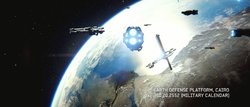
Prior to the Human-Covenant War, the UNSC Navy had a large fleet of warships, including many capital ships and single-ship craft. However, beginning with the near-total destruction of the Colonial Military Authority's Battle Group 4 at the First Battle of Harvest, followed by the loss of thirteen out of forty ships at the Second Battle of Harvest, the UNSC Navy sustained heavy losses of materiel and personnel throughout the war against the Covenant. Going on the offensive from 2526 to 2543, the bulk of the UNSC Navy under Admiral Preston Cole fought a series of victorious but enormously costly actions against the Covenant fleet.[6] To buy the fleet time to prepare, Cole launched Operation: SILENT STORM where Task Force Yama inflicted as much damage as possible on the Covenant through stealth to give them pause while Battle Group X-Ray kept the main Covenant force distracted. The task force was able to cause substantial damage to the operations of the Covenant Fleet of Inexorable Obedience and caused heavy damage to the Covenant planet of Zhoist.[10]
At the Battle of Alpha Aurigae in the Origami Asteroid Field in October 2526, a total of 117 UNSC naval vessels defeated the Covenant's twelve—at least three of which were CAS-class assault carriers. However, thirty-seven UNSC ships were lost. The Battle of XI Boötis A in 2528 saw the loss of thirty ships out of the UNSC's seventy to the Covenant.[11] The Battle of the Great Bear at the Groombridge 1830 system in 2530 saw eleven destroyers out of the fleet of seventeen destroyed by three enemy ships.[11]

By 2536, the Covenant had begun to encroach on humanity's Inner Colonies. To prevent the Covenant from discovering more human colonies or Sol itself, Admiral Preston Cole established the Cole Protocol. The protocol forbade retreating vessels from setting a direct slipspace course toward any colony and dictated the destruction of navigation data on Covenant-captured naval ships. Every shipboard commanding officer in the Navy was ordered to read the new protocol.[12] Some naval vessels, such as UNSC Midsummer Night, were ordered to patrol UNSC space to enforce the Cole Protocol.[13] In 2543, the UNSC Navy scored one final offensive victory against the Covenant at the Battle of Psi Serpentis, though at the cost of the apparent death of Preston Cole.[6] Towards the end of the Covenant War, most remaining UNSC ground forces were consolidated on worlds in the Epsilon Eridani and Sol systems. As a result, the only representative that several surviving colonies had of UEG authority and defense were UNSC Navy ships. While the Navy attempted to provide aid to colonies cut off from direct military assistance, worlds with little strategic value or unstable local governments were sometimes abandoned to prevent risking the loss of irreplaceable Navy vessels and personnel.[14]
In 2552, the Navy scored a morale-boosting victory at Sigma Octanus IV, but this was quickly offset by the crippling military losses of the Fall of Reach and the Battle of Tribute. The Navy lost over a hundred ships, including irreplaceable cruisers and carriers such as the UNSC Basra, UNSC Trafalgar, and the UNSC Musashi at Reach,[15][16] and lost ninety percent of naval assets at Tribute.[17] In the same year, most of the remaining forces of the UNSC Navy retreated to Earth and were merged with the Home Fleet prior to the Battle for Earth.[18] A very large portion of the combined fleet were lost when the Prophet of Truth's final military forces arrived at Earth in mid November 2552.[19] As a result, the UNSC Navy was only able to make a contribution of at least seven frigates[20] to the Battle of Kenya and the Battle of Installation 00, with the Sangheili navy handling most of the space fighting.[21]
Post-war[edit]
In the aftermath of the Human-Covenant War, all remaining naval assets were gathered to the Sol system for months so that the UNSC could take stock of its fleet. This time was spent accounting for, repairing, and refitting what little remained—only a few hundred vessels.[22] The Office of Naval Intelligence began operations to sow dissent amongst the Sangheili, disregarding their wartime alliance in the hopes of rendering them unable to fight should they become a threat again. Among this operation's effects was the beginning of the Blooding Years and the establishment of a Covenant remnant led by Jul 'Mdama.[23] While the former Covenant fleet's naval vessels fell into the hands of various splinter factions established by the former client species,[24][25] the UNSC Navy began to rebuild and continued to grow.[26] In the aftermath of the war, the rapidly modernizing Navy introduced the Autumn-class heavy cruiser, based on the highly resilient advancements applied to the UNSC Pillar of Autumn as well as the Strident-class heavy frigate and the Anlace-class light frigate among others, rapidly supplanting the prewar designs still central to the UNSC Navy.
In early 2553, the Navy launched its most powerful warship, the UNSC Infinity, though she would not be officially commissioned for another four years. Built in secret using technology recovered from Forerunner and Covenant sources during the war, the Infinity is the UNSC's largest and most advanced warship to date.[27] In March 2553, she secretly intervened in the Sangheili civil war, and demonstrated the UNSC's new technical capabilities by easily destroying the Covenant destroyer Defender of Faith.[28] A second such ship of the Infinity-class, the UNSC Eternity, was still in development as of 2558.[29]
In March 2555, the Navy had to defend Earth itself from an invasion by Retriever Sentinels sent by 000 Tragic Solitude from Installation 00 to destroy the planet in retaliation for the damage done to the installation by the Battle of Installation 00. A joint mission with the Swords of Sanghelios was dispatched to the Ark while the fleet struggled to hold off the invasion. Finally, Tragic Solitude was forced to recall his invasion force before the planet could fall and was subsequently destroyed by Bobby Kodiak after descending into full rampancy. A fleet was sent to the Ark to investigate what had happened and rescued the survivors of the mission.[30]
In July 2557, the Infinity distinguished herself during the Battle of Requiem and the recovery of Master Chief Petty Officer John-117. The UNSC Navy's forces around Earth had also been rebuilt, and the Home Fleet defended the planet against the Didact when he arrived with the intention of digitizing all of humanity with the Forerunner weapon known as the Composer. Earth's orbital platforms and the Home Fleet's Battlegroup Dakota had little to no effect against the Didact's ship, the Mantle's Approach, but the Infinity managed to damage the ship, allowing John-117 to enter using an F-41 Broadsword and destroy the ship with a HAVOK tactical nuclear weapon. The fighting continued six months later with the Infinity's second expedition on Requiem.[31]
Also in July 2557, the UNSC launched a massive fleet to the Korinth Prior system after the discovery of the debris field of Trove, a Forerunner shield world destroyed in 2531 by the UNSC Spirit of Fire. The fleet launched a massive bombardment of nuclear weapons upon arrival, obliterating the shield world remnants in an act of asset denial as the field was too large for the UNSC to cover effectively.[32]
On October 28, 2558 the UNSC Navy was largely incapacitated by Cortana's Guardians, with only a few ships, including Infinity, managing to escape the Created.[33][34]
Organization[edit]
Command and control[edit]
- Main article: UNSC Naval Command
The UNSC Navy is subordinate to the UNSC High Command (HIGHCOM). The Navy is administered by the UNSC Naval Command, or NAVCOM, headed by the Chief of Naval Operations, which in 2558 was Fleet Admiral Lord Hood. The CNO is assisted by the Deputy Chief of Naval Operations.[35] NAVCOM is split into three commands;
- Fleet Command, or FLEETCOM, has oversight of ship deployment, mission structures, and space operations, including the transport of troops and naval fighter operations. It is the largest and most powerful component of any NAVCOM grouping.[36]
- Naval Logistical Operations Command, or NavLogCom, oversees the construction, maintenance, and distribution of supplies and matériel, including ships, ammunition, replacement parts, and food.
- Naval Special Warfare Command, or NAVSPECWARCOM, and Naval Special Weapons (NAVSPECWEP) are responsible for all Naval special operations, including deployments of SPARTAN-IIs.[37] They provide mission parameters, ships and specialist personnel to support Spartan actions in deep space or planetary orbit.[36]
The UNSC Navy also operates with UNICOM forces to form one of four Central Commands (CENTCOM) which hold responsibility over a certain area of space. These territories are known as CentCom regions, and follow well-mapped routes that connect star systems together. Forces assigned to one CentCom region can not be moved to another without HIGHCOM approval[38] However, a CENTCOM commander has the authority to blockade a system,[4] or aid in the coordination of a battle occurring within the regional space they command.[39] UNSC and UEG space is further divided, governed, and protected by the Navy's Fleet Command sectors which each contain a number of planetary systems.[40]
The Office of Naval Intelligence is technically subordinate to the UNSC Naval Command. In practice, however, ONI's activities extend far beyond intelligence gathering, and it often receives mandates and directives from HIGHCOM or even higher.[37] ONI holds a strong presence in the UNSC fleet and maintains joint control of the Navy's post-war flagship, UNSC Infinity.[41] Despite being under the command of the Navy, ONI's Commander-in-Chief holds a seat on the Security Council with equal stature and privilege to the committee members of the Navy, Marines, Army, and Air Force.[42]
Commanding positions in NAVCOM tend to be held by admirals.[35][43][44] Because of their role as an "amphibious", space-deployed force, the UNSC Marine Corps enjoys a close relationship with the Navy, with Marine complements being deployed on most warships.[43][45][46]
Operating forces[edit]
UNSC Navy forces are divided into a number of fleets. These tend to be large formations, though they seldom patrol together; single ships are commonly seen patrolling throughout UNSC space.[46] System defense fleets, such as the UNSC Home Fleet, the Epsilon Eridani Fleet or Bliss Defense Fleet, are commonly formed to patrol and defend a human colonized-system.[14][47] Defense fleets were often considered to be little more than glorified revenue police, though they proved to hold an imperative role during the Human-Covenant War as they provided desperately needed training cadres and battle-ready—albeit, sometimes outdated—warships.[14] Defensive fleets typically find a smaller "tactical" carrier at their core.[5] The UNSC Navy also has several numbered expeditionary fleets,[14] five of which were active during the Covenant War—the Second, Third, Fifth, Seventh, and Sixteenth Fleets.[48] Several expeditionary fleets were decimated early in the Covenant War. Expeditionary fleets find their core comprised of massive supercarriers such as the Epoch-class, which formed the core of many UNSC fleets and battlegroups during the Insurrection and early Covenant War.[5]
Fleets are typically assigned to sectors, groupings of Inner and Outer Colonies organised by the most efficient slipspace routes branching away from Reach. By late 2552, there was no longer any appreciable difference between fleets, as the Navy was no longer capable of conducting offensive operations without leaving the remaining colonies and Earth vulnerable- despite this, the navy maintained these divisions.[14] By this time, however, the navy was the only representation of the UEG had in the colonies, as all remaining ground forces had been consolidated at Earth and Reach.[14]
These fleets are further divided into several battle groups,[49] more common tactical formations which are formed on an as-needed basis and vary dramatically in size from three ships to large carrier groups[6][44][50][51] with smaller tactical carriers at their core.[5] Battle groups are flexible fighting organizations that can be "plugged together" into arranged task forces. A squadron is a group of warships that is smaller than a fleet. By the final years of the Covenant War, squadrons became administrative—rather than tactical—units that ships were enrolled in for record-keeping and honorific purposes. Artificial intelligence administrators of the Navy carefully arranging the dwindling ship roles into attack, battle, carrier, monitor, and support squadrons. Many of the Navy's fleets had also become "paper fleets", or "dead fleets", with no command and no ships. These fleets were assigned to sectors lost to the Covenant early in the war, with their destroyed squadrons remaining attached to the sector to honor their sacrifice and as deference for tradition. A new ship was occasionally inadvertently attached to one of these dead fleets due to bureaucratic error, though such assignments were considered ill omens by their crew members.[14]
Personnel[edit]
Large numbers of men and women are employed by the UNSC Navy. Servicepeople hold ranks, which are divided between officers and enlisted. UNSC Navy personnel are given training in self-defense. All crewmen are trained to use the M6 series of handguns.[52] Naval personnel are sometimes referred to as "swabbies", which can be a joke or a sign of disrespect.[1][53] Navy recruits serve in initial recruit training operated by the Unified Combined Military Boot Camp. At boot camp, recruits are trained, tested, and evaluated on their physical fitness, proficiency with firearms, and command potential. Following graduation from UCMB, a naval recruit may be required to complete additional training revolving around the vacuum of space and microgravity. Finally, a recruit is assigned aboard a naval vessel or installation as a non-commissioned recruit within the Navy.[54] Several human colonies are home to Officer Candidate Schools that provide training and allows enlisted personnel or civilians to become officers.[55] Renowned OCS academies include the Luna OCS Academy and the Corbulo Academy of Military Science.[56]
UNSC Navy personnel wear distinctive uniforms for identification, comfort, and practicality. Dress uniforms are worn on formal occasions, such as ceremonies and other official functions,[43] while service and working uniforms are the basic uniform worn by UNSC Naval personnel while on duty.[57][58] Carrier flight crew are a mix of Navy and Marine personnel, divided into "Blue" and "Green" sides respectively, with coloured jerseys signifying their role on the flight deck: red for ordnance handlers, white for safety technicians, green for technicians, and so on.[5]
Whilst crewing a war-era UNSC navy vessel, crew members could expect cramped and strictly utilitarian conditions, with most vessels forgoing recreational space and only having rudimentary kitchen facilities. Crew members are allocated a sleeping pod, with multiple crewmembers using the same sleeping pod depending on shift rotation on the ship and if the ship carries additional personnel.[59]
A full list of Naval personnel can be found here. For a list of ranks within the UNSC Navy, see UNSC rank structure.
Logistics[edit]
Armor[edit]
UNSC Navy vessels are typically armored with Titanium-A armor; such protective armor remained the defensive standard of UNSC vessels[60] until they were further reinforced with the introduction of energy shielding in the post-war era. At least the Navy's flagship, UNSC Infinity, and Strident-class heavy frigates are equipped with energy shields,[61] while Autumn-class heavy cruisers featured a cheaper but more limited system of localised shield emitters.[62]
Weapons[edit]
The primary offensive armament of UNSC spacecraft is the Magnetic Accelerator Cannon (MAC). These are high velocity coil guns that are used to accelerate projectiles ranging in mass from 600 metric tons in the case of smaller warships, and 3,000 tons in the case of Super MAC platforms. These projectiles are composed of titanium, depleted uranium, or tungsten with a ferrous core.
The UNSC frigate Gettysburg is quoted as firing a 600 ton shell at 30 kilometers per second.[63] Before Reach fell, the UNSC Pillar of Autumn was equipped with a modified MAC that could quickly fire three lighter projectiles in succession instead of just one heavier projectile. It was originally intended to allow the Pillar of Autumn a better chance of disabling a Covenant ship, which was a feature required for a mission that was later scrubbed following the Fall of Reach.
Almost all UNSC warships are equipped with M58 Archer missile pods for ship-to-ship engagements, which prove most effective against unshielded targets. A common tactic among UNSC ships is to disable the target's shields with MAC rounds and then pummel it with Archer missiles.[64] In 2525, UNSC ships carried fusion missiles as an offensive weapon.[65] They seem to have been removed or replaced in later years. UNSC ships may also carry Shiva-class nuclear missiles.[66] In addition, the UNSC mounts 50mm auto-cannons on its ships for defense against enemy fighters and boarding craft, controlled by shipboard AIs.[67]
UNSC warships also carry significant Marine detachments for internal security, boarding actions, and planetary assault, and carry all the equipment and matériel needed by Marine forces. It is implied that a significant portion of the interior of UNSC warships are devoted to this purpose, as there are armories and barracks that hold these supplies.
Ships of the UNSC Navy also carry a number of GA-TL1 Longsword interceptors. These are armed with 110mm rotary cannons and ASGM-10 missiles, and sometimes a M1011 Moray space mine system or even a single Shiva-class nuclear missile. They can also be remotely-operated and used to carry a remotely-detonated Shiva missile, which, when detonated, effectively destroys both the Longsword and its selected target.[68]
Despite all of this firepower, however, UNSC warships during the Human-Covenant War had great difficulty in defeating Covenant ships even with a numerical advantage. It typically took multiple hits from a ship-based MAC weapon to disable a Covenant ship's shields, although larger, ODP-based "Super MACs" fire a round that can literally shatter Covenant capital ships.[69] Archer missiles had to be used in tremendous volumes to breach Covenant shield systems. Even with their shields down, Covenant ships have been noted to remain operational after multiple direct hits from normal MAC rounds. Throughout the Human-Covenant War, this advantage in firepower and shielding gave the Covenant an effective 3:1 ratio when in battle against the UNSC. However, as of the post-war era, thanks to Forerunner technology and the Huragok retrieved from Onyx, UNSC ships have become faster and stronger, making them more effective against Covenant vessels.
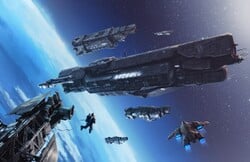
Ships[edit]
- Main article: UNSC starship
The largest vessels of the UNSC fleet are carriers and supercarriers.[46] While possessing weapons of their own, their primary role is to deploy fighter craft such as the GA-TL1 Longsword, and may serve as flagships in fleet actions.[44] If a carrier is unavailable, however, then heavily-armed and armored cruisers may fill this role.[46] The UNSC Navy has fielded numerous carrier types, among them the Epoch-class heavy carrier, the Orion-class assault carrier, and the postwar Poseidon-class light carrier. The Punic-class supercarriers, among the largest vessels in human history, upheld the Navy's outreach and field capabilities as "Space Control Vehicles" before assuming offensive roles in the Human-Covenant War. The Punic-class was one of the few vessels to rival those of the Covenant in terms of tonnage and firepower. The current flagship of the UNSC Navy is the UNSC Infinity, the first of the Infinity-class supercarriers which make use of defensive and offensive advances reverse-engineered from both Forerunner and Covenant technologies, with the specific intention of matching Covenant warships in terms of offensive firepower.[27] The UNSC Navy has operated four known classes of cruiser; the Marathon-class heavy cruiser, the Valiant-class super-heavy cruiser, the now-obsolete Halcyon-class light cruiser, and the postwar Autumn-class heavy cruiser.[70]
UNSC destroyers and frigates of various classes are used for escorting larger cruisers and carriers, as well as for independent patrol and scouting operations. Both are roughly the same size, but destroyers are designed with greater emphasis on firepower and armor over versatility.[71][72] Frigates are multi-purpose warships that are used in a broad range of roles, ranging from heavy air support to fighter escort and fleet engagements. Some UNSC frigates are equipped with a sizeable cargo bay for larger dropships and armor complements. The UNSC has also employed light frigates equipped with stealth systems in a specialized reconnaissance role.[73]
The Navy maintains a wide variety of smaller craft and support ships. These include prowlers for electronic intelligence gathering, refit stations, exfiltration craft, shuttles, and corvettes. Corvettes are notable as being one of the fastest ships in the UNSC Navy,[74] and a number of sub-classes have been developed including the Mako-class[75] and the fast-attack corvette.[76]
Th primary shipyards utilized by the UNSC Navy are on and in orbit of Mars,[77] with at least some UNSC ship production handled by the Reyes-McLees Shipyards over Mars.[78] Tribute is also host to prominent shipbuilding yards. By the end of the Covenant War, the shipyards orbiting Tribute and Mars began building a new generation of Strident-class heavy frigates and Anlace-class light frigates,[79] among other warships for the UNSC to replace losses.[80] Additionally, SinoViet Heavy Machinery manufactured and decommissioned Paris-class heavy frigates[81] and Stalwart-class light frigates[82] on Reach prior to the Fall of Reach. UNSC naval design guidelines emphasise that the command crew of a given ship be given visibility of the surrounding area, a tradition hearkening back to the age of naval warfare on Earth.[59] Because of this, UNSC naval vessels are prone to have bridges exposed to space.
Space fighters[edit]
Space fighters are small, maneuverable spacecraft, often used for bombing or "dog fighting" in space or in an atmosphere. The UNSC Navy operates a number of fighters, the most common of which is the GA-TL1 Longsword. The Longsword is a multi-role fighter that can be used in a variety of missions, including ground support, anti-ship attacks, and combat with other fighters.[46][68]
The F-41 Broadsword is a multirole space fighter in use during and after the Human-Covenant War. Like the Sabre, the Broadsword is equipped with energy shielding that covers the entire fighter and recharges when depleted. However, these shields are not rated for slipspace travel. The Broadsword is equipped with two M1075 ASW/AC 35mm MLA cannons and two M6088 ST/MMP missile pods. The fighter can also be equipped with a single piece of heavy ordnance, such as a HAVOK warhead.[83] Broadswords were manufactured in the tens of thousands, and operated by both Navy and Air Force.[84]
A less common UNSC fighter is the OF92/EVA "Booster Frame". The Booster Frame is an experimental fighter developed as a prototype. They are specifically designed for extra-vehicular activity and special operations and Spartan roles, dropped from hooks within the hangars of specialized UNSC ships. The fighter itself has no sealed cockpit, so a pressurized suit must be worn in order to operate the vehicle.[79][85][86]
Identified UNSC vessels and stations[edit]
Vessels[edit]
- Main article: UNSC starships
Stations[edit]
Other orbital facilities[edit]
|
Mobile stations[edit]
Remote scanning outposts[edit]
|
Medical stations[edit]
|
Trivia[edit]

|
Check out our collection of quotes related to UNSC Navy on its quotes page. |
As with the rest of the UNSC military, the structure and many of the traditions in the UNSC Navy are based on those in the United States Navy.
Gallery[edit]
Models of UNSC Naval personnel in Halo 4.
UNSC Naval personnel aboard the UNSC Spirit of Fire in Halo Wars 2.
The UNSC Cradle, a specialized refit station capable of slipspace travel, takes the offensive along with numerous UNSC Navy ships in the Battle of Sigma Octanus IV.
The refit station Anchor 9, one of many such stations during the Battle of Reach; the frigate UNSC Savannah is docked with the station.
A Strident-class heavy frigate, two Vindication-class light battleship, and a Poseidon-class light carrier over Earth in the post-war era.
UNSC Navy ships in Halo: Fleet Battles.
A Navy recruitment advertisement in Mombasa, East African Protectorate.
List of appearances[edit]
References[edit]
- ^ a b Halo: The Flood, page 100
- ^ Halo: Glasslands, page 64
- ^ a b c d e f Halo: Official Spartan Field Manual, p.126
- ^ a b Halo: Evolutions, "The Impossible Life and the Possible Death of Preston J. Cole", pages 436-437
- ^ a b c d e Halo: Warfleet, p.40-41
- ^ a b c d e Halo: Evolutions, "The Impossible Life and the Possible Death of Preston J. Cole"
- ^ Halo Encyclopedia (2009 edition), page 44 (2011 edition)
- ^ Halo: Contact Harvest, pages 9-20
- ^ Halo: Evolutions, "The Impossible Life and the Possible Death of Preston J. Cole", page 457
- ^ Halo: Silent Storm
- ^ a b Halo: Evolutions, "The Impossible Life and the Possible Death of Preston J. Cole", page 470
- ^ Halo: The Cole Protocol, page 33
- ^ Halo: The Cole Protocol, page 36
- ^ a b c d e f g Halo: Fleet Battles core rulebook, page 9
- ^ Halo: The Fall of Reach, page 320 (2001 edition)
- ^ Halo: First Strike, page 168 (2003 edition); page 206 (2010 edition)
- ^ Halo 3: ODST, Dutch's biography
- ^ Halo Legendary Crate, Data Drop #2
- ^ Halo 3, campaign level Crow's Nest
- ^ Halo Mythos, page 117
- ^ Halo 3, campaign levels The Storm, Floodgate, and The Ark
- ^ Halo Mythos, page 132
- ^ Halo: Glasslands, page 22
- ^ Halo 4: The Essential Visual Guide, page 195
- ^ Eleventh Hour reports, Report 2
- ^ Halo: Glasslands, page 43
- ^ a b Halo: Glasslands, pages 421-422
- ^ Halo: The Thursday War, page 303
- ^ Halo: Warfleet, page 42
- ^ Halo: Hunters in the Dark
- ^ Halo 4, campaign level Midnight
- ^ Halo: Renegades, Chapter 24
- ^ Halo 5: Guardians, campaign level Guardians
- ^ Halo: Fractures, Rossbach's World
- ^ a b Halo: First Strike, page 22
- ^ a b Halo: Official Spartan Field Manual, p.124-125
- ^ a b Halo Encyclopedia: The Definitive Guide to the Halo Universe, page 64 (2011 edition)
- ^ Halo: Official Spartan Field Manual, p.122-123
- ^ Halo: Reach, Reflection radio conversation
- ^ Halo: The Fall of Reach, page 289
- ^ Halo: The Thursday War, page 46
- ^ Halo: Escalation, Issue #1
- ^ a b c Halo 2
- ^ a b c Halo: Ghosts of Onyx
- ^ Halo: Combat Evolved
- ^ a b c d e Halo: The Fall of Reach
- ^ Halo 2, campaign level Cairo Station
- ^ Halo: Ghosts of Onyx, page 205
- ^ Halo: The Essential Visual Guide, page 188
- ^ Halo Wars: Genesis
- ^ Halo Graphic Novel, page 86
- ^ Halo: Combat Evolved, campaign level The Pillar of Autumn
- ^ Halo: First Strike, page 92
- ^ Halo: Evolutions, "The Impossible Life and the Possible Death of Preston J. Cole", page 421
- ^ Halo: The Fall of Reach, page 38
- ^ Halo 4: Forward Unto Dawn, Part 1
- ^ Halo: Contact Harvest, page 322
- ^ Halo 2, campaign level Delta Halo
- ^ a b Halo: Warfleet, p.32-33
- ^ Halo: Ghosts of Onyx, page 185
- ^ Image showing frigate shields above hull
- ^ Halo: Warfleet, p.26-27
- ^ Halo: The Fall of Reach, page 108 (2001 edition); page 130 (2010 edition)
- ^ Halo: The Fall of Reach, page 128 (2010 edition)
- ^ Halo: The Fall of Reach, page 118
- ^ Halo: The Fall of Reach, page 147
- ^ Halo: The Fall of Reach, page 19
- ^ a b Halo: The Essential Visual Guide, page 112
- ^ Halo: The Fall of Reach, page 297
- ^ Halo 4: The Essential Visual Guide, page 191
- ^ Halo: The Fall of Reach, page 139
- ^ Halo: Evolutions, "Midnight in the Heart of Midlothian"
- ^ Halo: The Cole Protocol, page 35
- ^ Halo: Ghosts of Onyx, page 213
- ^ Halo: The Fall of Reach, page 85
- ^ Halo: Contact Harvest, page 60
- ^ Halo Waypoint: Canon Fodder - Have S'moa
- ^ Halo: The Fall of Reach, page 238
- ^ a b Halo: Warfleet, p.38-39
- ^ Halo Waypoint: Canon Fodder - Buzz Generating
- ^ Halo: Reach, campaign level, New Alexandria
- ^ Halo: Warfleet, p.36-37
- ^ Halo 4: The Essential Visual Guide, page 114
- ^ Halo: Warfleet, p.28-29
- ^ Halo Waypoint, Gauss Technology article
- ^ Halo Waypoint, Booster Frame article
Sources[edit]
